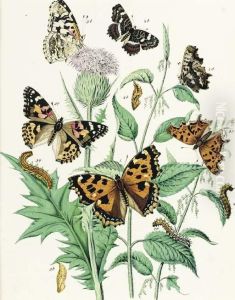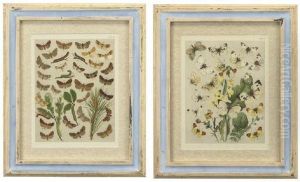William Kirby Paintings
William Kirby was a renowned British entomologist, not primarily known as an artist in the traditional sense of painting or sculpture, but rather as a pioneering figure in the scientific illustration and study of insects. Born on September 19, 1759, in Witnesham, Suffolk, England, Kirby's interests and contributions spanned the fields of natural history, particularly entomology, the study of insects. His work laid foundational stones for the scientific community's understanding of insects and their classification.
Kirby was educated at Ipswich School and later at Caius College, Cambridge, where he initially studied classics before turning his attention to natural history. His passion for the natural world, and insects in particular, was deeply influenced by the broader Enlightenment period's emphasis on observation, classification, and the scientific method. Kirby's approach to entomology was meticulous and pioneering, combining keen observational skills with a deep reverence for the natural world, which was somewhat reflective of his deep religious convictions as a rector in the Church of England.
One of Kirby's most significant contributions to entomology was his collaborative work with William Spence, 'An Introduction to Entomology,' published in four volumes between 1815 and 1826. This work was monumental in its scope and detail, offering comprehensive insights into insect life, their behaviors, environments, and interactions with humans. It became a foundational text in the field of entomology, celebrated for its thoroughness, observational precision, and the clarity of its illustrations, which were crucial for the study of insects at the time.
Kirby is also noted for his classification system and his efforts in cataloging British insects, notably his work 'Monographia Apum Angliae' (1802), which focused on the bees of England. His classifications and systematizations of insects contributed significantly to the burgeoning field of entomology, influencing subsequent generations of naturalists and scientists.
Throughout his life, Kirby maintained a correspondence with other leading figures in the scientific community, contributing to the exchange of knowledge and ideas that was so central to the Enlightenment era's intellectual landscape. He was recognized for his contributions to science by being elected a fellow of the Linnean Society of London and the Royal Society.
William Kirby passed away on July 4, 1850, in Barham, Suffolk, leaving behind a legacy as a pioneer of entomology. His work not only advanced the scientific study of insects but also contributed to the broader appreciation of the natural world, laying the groundwork for future research and conservation efforts. Kirby's life and work exemplify the intersection of art, science, and religion during a pivotal period in history, making him a figure of enduring interest to historians of science and art alike.

